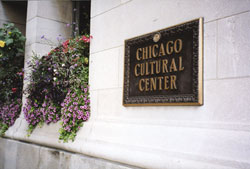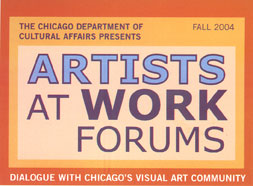What the Department of Cultural Affairs Offers you
By Amber Smock
If you’re planning to live and work as an artist in the city of Chicago, chances are that the city government will play a role in your life. Not only does the city offer grants, exhibition opportunities and commissions, it also oversees the zoning that affects living/work spaces and partners with arts organizations to monitor the pulse of the art scene. The city offers much more for artists than you may be aware of; plus, it’s on the quiet brink of an arts information revolution.
The city’s center for arts-related business is the Department of Cultural Affairs (DCA), headquartered on the fourth floor of 78 E. Washington, a.k.a. the Chicago Cultural Center. A significant amount of cultural activity/funding is also coordinated by the Chicago Park District, and the Department of Buildings oversees zoning and code enforcement. It is the DCA, however, that exists for Chicago’s cultural life alone, and it is moving towards a near-total inclusiveness of arts-related services.
Over the past five years or so, the DCA has been working on identifying artists’ needs, from space to venues to professional advice and training. The general upshot: artists have many needs, but the key issue, as identified by the 2003 DCA Strategies for Chicago Visual Artists study, is that artists most need information about their resources. A wide variety of arts-related options and resources exist for us, but do we know about them? Read on to test your city government arts knowledge.
Making Your Art Happen Here, Today
You want to take advantage of city resources right away? Right now? Start with the DCA’s semi-monthly dialogue series called the Artists at Work Forums, coordinated by Barbara Koenen, an artist and project manager in DCA’s Cultural Planning Division. The sessions cover issues of concern to artists such as housing, art education, collectives, and an upcoming session on artists’ safety with Dr. David Hinkamp, on December 9 at 6 p.m. Sessions are free and open to the public, and are held in the fifth floor southwest meeting room of the Cultural Center.
DCA’s collaborative Programming division is an excellent source of resource referral and ongoing technical assistance for artists. Collaborative Programming provides comprehensive cultural planning support, workshops, forums, and visual, performing, and literary arts registries. Collaborative Programming oversees collaborations such as the Arts Management Services Network (AMSN) and the Chicago Cultural Network. These groups meet regularly to, in Koenen’s words, “take the pulse of the arts from a service point of view.”
Current DCA resources online include the searchable City of Chicago Arts Directory, which lists contact information for arts organizations around Chicago. In addition, artists can sign up for !!Arts Flash!!, an e-mail news bulletin featuring artists’ professional development opportunities, collaborative opportunities, resources and promotions.
No DCA information checklist would be complete without a rundown on the Cultural Grants division. There are four basic categories of grants, but the most relevant one right now for SAIC students is the Community Arts Assistance Program (CAAP), which provides support to new and emerging artists and arts organizations. Up to $1,000 can be requested for professional, organizational, and artistic development. The 2005 CAAP deadline is this December 10 at 5 p.m. Applications are available online and at the DCA, as well as at other locations citywide. Applicants should attend a CAAP application workshop, held from November 4 to November 18. Also, a special workshop called “Writing Artist’s Statements for Grants” will be held on November 30 from 5:30 – 7:30 p.m. in the Cultural Center.
Get acquainted, too, with the Public Art Program, which offers artists opportunities to create works of art in municipal buildings. Funding comes from the Percent-for-Art Ordinance, which stipulates that 1.33 percent of funds for constructing or renovating city buildings be set aside for art commissions. Most recommended artists come from the Artists Slide Registry, composed of work by local artists. Any Chicago artist can submit work for the registry.
Additionally, the Public Art Program administers the city’s venues for exhibiting art, such as the photography gallery in the Water Tower and the Cultural Center itself. Temporary venues may also be coordinated through the city by using building or spaces that are in transition. The Public Art Program also administers the Open Studio program, which offers space to work on a temporary basis; call (312) 744-6630 for details.
Ongoing City Opportunities for Your Art
Chicago Artists Month, held each October, is a terrific opportunity for artists to promote their work. Any artist or arts group can sign up to participate. “Chicago Artists Month basically lets artists take the initiative to do what they want to do, and then we market the hell out of it,” says Koenen. “Anyone can do it.” The effort is geared towards promoting the excellence of Chicago artists and the excellence of Chicago as a cultural epicenter.
Since 1999, the DCA has begun concentrating more and more effort on artists’ housing. The city is developing four artists’ housing projects on the North, South and West sides. However, these projects are not slated to open for another couple of years. A more current opportunity is the annual Artists Space and Housing Expo, the first of which was held last April and attracted 1,300 artists for a day of resources on buying and renting space. The entire series of workshops from the first Expo is available on compact disk for checkout from the Harold Washington Library. The next Expo is scheduled for May 2005.
Another annual event to keep an eye out for is Spotlight on Chicago, presented as the kickoff of the fall arts season at the Cultural Center. Local arts and cultural organizations get together to present their upcoming programs and art education initiatives.
The City’s Gallery 37 program provides opportunities to teach Chicago youth. Gallery 37 helps provide young people with cultural education while they earn a stipend and learn job skills. Classes range widely, from cooking to ceramics. You can visit Gallery 37 at 66 E. Randolph, and don’t forget to visit the CenterSpace Gallery on the fifth floor.
The Future of the Chicago City-Artist Relationship
Currently, Koenen notes that artists can contact the city in the following ways: through the www.cityofchicago.org website, via a phone call, and through contacts made at public meetings, fairs or forums. The city website in particular will guide artists to what they need. The site is for all city services, however, not just the arts alone.
The DCA decided to create an individual city site for artists largely as a result of the 2003 survey, Strategies for Chicago Visual Artists (www.chicagoartistresource.org), part of the DCA’s Empowering Visual Artists Initiative. The survey’s primary findings confirmed, yet again, needs often discussed in arts circles: affordable living and workspace, greater community, professional development and, most importantly, the desire for a Chicago information clearinghouse.
The surveyors, led by Koenen, culled much of their final result from speaking to individual artists and focus groups, but they also added the Internet as a research tool. They looked at website resources offered in other cities, such as the Seattle Arts Resource Network (www.artsresourcenetwork.org), the Artists’ Information Company (www.a-n.co.uk), and Toronto Artscape’s “Square Feet” housing site (www.torontoartscape.ca). As a result, the DCA decided to pursue the construction of a website geared specifically towards the needs of Chicago artists.
The new website, named the Chicago Artists’ Resource (CAR), will be launched in conjunction with the October 2005 Chicago Artists’ Month. It will include basic information on a range of artists’ services, from space and housing to professional practice, from artists’ working stories to registries and advocacy and much, much more. Two SAIC alumni are currently heavily involved: Sara Schnadt, the content and web design coordinator, and LaShawnda Crowe Storm, the space and housing coordinator.
The survey and the website have been funded not by the city, but rather through outside funding organizations such as the Emily Hall Tremaine Foundation. When asked about the funding of the projects, Koenen noted that the city pays for its staff, while taxes pay for the cultural grants. However, it is the norm for many DCA projects to be paid by outside grantors. “There is more freedom if you get your own money, too,” says Koenen, “and there are more opportunities for partnerships and collaboration.”
She also points out that the DCA hopes that the web will prove to be a more reliable arts directory source, since sometimes when artists call in for information, the person answering the telephone may not be conversant with all the areas of DCA. To ensure that those now currently without Internet access get the chance to access the CAR, the DCA will partner with agencies and organizations such as the Chicago Public Library to provide access to the site on their computers. Workshops to teach people how to use the CAR will also begin when the site is launched in October 2005.
The study recommended that the city also pursue the following: facilitation of space assistance programs for artists, the creation of a citywide council of artists, and national and international promotion of Chicago-based artists.
What motivates those within DCA to work so hard and take on so many goals on behalf of the artists in this city? Well, Koenen says, “I love the work of artists in Chicago. I love that people are creative and making art. We love helping them figure out how to get it done.”
Look up the Department of Cultural Affairs in the “departments” section of www.cityofchicago.org. For more information on the CAAP grants and workshops, call (312) 744-9797 or (312) 744-1742. and for the Artists at Work Forums, call(312)744-6630. Visit www.chicagoartistsresource.org for the city’s study on artists’ needs. To sign up for !!Arts Flash!!, an e-mail news bulletin for artists, send an e-mail to [email protected]. Members of the public may also attend quarterly meetings of the Public Art Committee. Meetings are held from 10 a.m. to 1 p.m. in the Cultural Center, with the next one on Thursday, December 9. In addition, please visit www.fnewsmagazine.com to read more about artists and the city, and to post art practice announcements on the F Blog.
Related Links:
www.cityofchicago.org
www.chicagoartistsresource.org








